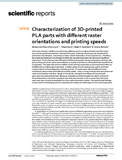Citation link:
http://dx.doi.org/10.25819/ubsi/10241| DC Field | Value | Language |
|---|---|---|
| crisitem.author.orcid | 0000-0001-8926-2346 | - |
| crisitem.author.orcid | 0000-0001-9840-6225 | - |
| crisitem.author.orcid | 0000-0002-7444-702X | - |
| dc.contributor.author | Khosravani, Mohammad Reza | - |
| dc.contributor.author | Berto, Filippo | - |
| dc.contributor.author | Ayatollahi, Majid R. | - |
| dc.contributor.author | Reinicke, Prof. Dr.-Ing. Tamara | - |
| dc.date.accessioned | 2023-01-03T07:55:22Z | - |
| dc.date.available | 2023-01-03T07:55:22Z | - |
| dc.date.issued | 2022 | de |
| dc.description | Finanziert im Rahmen der DEAL-Verträge durch die Universitätsbibliothek Siegen | de |
| dc.description.abstract | Fabrication based on additive manufacturing (AM) process from a three-dimensional (3D) model has received significant attention in the past few years. Although 3D printing was introduced for production of prototypes, it has been currently used for fabrication of end-use products. Therefore, the mechanical behavior and strength of additively manufactured parts has become of significant importance. 3D printing has been affected by different parameters during preparation, printing, and post-printing processes, which have influence on quality and behavior of the additively manufactured components. This paper discusses the effects of two printing parameters on the mechanical behavior of additively manufactured components. In detail, polylactic acid material was used to print test coupons based on fused deposition modeling process. The specimens with five different raster orientations were printed with different printing speeds. Later, a series of tensile tests was performed under static loading conditions. Based on the results, strength and stiffness of the examined specimens have been determined. Moreover, dependency of the strength and elastic modulus of 3D-printed parts on the raster orientation has been documented. In the current study, fractured specimens were visually investigated by a free-angle observation system. The experimental findings can be used for the development of computational models and next design of structural components. | en |
| dc.identifier.doi | http://dx.doi.org/10.25819/ubsi/10241 | - |
| dc.identifier.uri | https://dspace.ub.uni-siegen.de/handle/ubsi/2435 | - |
| dc.identifier.urn | urn:nbn:de:hbz:467-24355 | - |
| dc.language.iso | en | de |
| dc.source | Scientific reports ; 12 (1), article number 1016. - https://doi.org/10.1038/s41598-022-05005-4 | de |
| dc.subject.ddc | 620 Ingenieurwissenschaften und zugeordnete Tätigkeiten | de |
| dc.subject.other | 3D-gedruckte PLA-Teile | de |
| dc.subject.other | Rasterausrichtungen | de |
| dc.subject.other | Druckgeschwindigkeiten | de |
| dc.subject.other | 3D-printed PLA parts | en |
| dc.subject.other | Raster orientations | en |
| dc.subject.other | Printing speeds | en |
| dc.subject.swb | Rapid Prototyping <Fertigung> | de |
| dc.subject.swb | Dreidimensionales Modell | de |
| dc.subject.swb | Fused Deposition Modeling | de |
| dc.title | Characterization of 3D-printed PLA parts with different raster orientations and printing speeds | en |
| dc.type | Article | de |
| item.fulltext | With Fulltext | - |
| ubsi.publication.affiliation | Department Maschinenbau | de |
| ubsi.source.doi | 10.1038/s41598-022-05005-4 | - |
| ubsi.source.issn | 2045-2322 | - |
| ubsi.source.issued | 2022 | de |
| ubsi.source.issuenumber | 1 | de |
| ubsi.source.pages | 9 | de |
| ubsi.source.place | Nature Publishing Group | de |
| ubsi.source.publisher | London | de |
| ubsi.source.title | Scientific reports | de |
| ubsi.source.volume | 12 | de |
| ubsi.subject.ghbs | ZHV | de |
| Appears in Collections: | Geförderte Open-Access-Publikationen | |
Files in This Item:
| File | Description | Size | Format | |
|---|---|---|---|---|
| Characterization_of_3D-printed_PLA_parts.pdf | 2.17 MB | Adobe PDF |  View/Open |
This item is protected by original copyright |
Page view(s)
325
checked on Jan 18, 2025
Download(s)
64
checked on Jan 18, 2025
Google ScholarTM
Check
Altmetric
Items in DSpace are protected by copyright, with all rights reserved, unless otherwise indicated.

